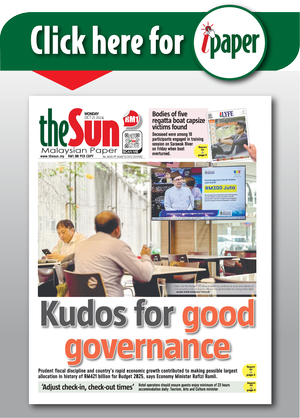PETALING JAYA: Gross exports for 2026 are forecast to increase by 2.8%, particularly for manufactured and agriculture goods, backed by the continued expansion of the electrical and electronic sector (E&E), according to the Finance Ministry’s Economic Outlook 2026 report released yesterday.
The report disclosed that this is driven by higher demand for semiconductor and AI edge applications, as well as competitive commodity prices.
Exports of manufactured goods are anticipated to expand by 3%, resulting from rising demand for both E&E and non-E&E products.
These products constitute shares of total manufactured goods at 50.4% and 49.6%, respectively. The E&E products are projected to grow by 3.9%, buoyed by steady demand for semiconductors.
This is in tandem with the continued technological upcycle, leading to a better performance outlook of the global semiconductor market at 9.9%, as reported by the World Semiconductor Trade Statistics.
Concurrently, exports of non-E&E products are estimated to rebound by 2.1% following higher demand, particularly for palm oil-based manufactured products; manufactures of metal; chemicals and chemical products; as well as machinery, equipment and parts.
Exports of agriculture goods are projected to grow by 3.3%, supported by sustained global demand for palm oil and palm oil based agriculture products, attributed to higher export volumes and competitive prices for agriculture goods.
Conversely, exports of mining goods are estimated to contract marginally by 0.4% on account of lower exports of LNG and crude petroleum, partly due to slower demand from major importing countries.
According to the report, gross imports are forecast to increase by 3.9% in 2026, supported by growth in all components, reflecting Malaysia’s steady performance in key economic sectors and strategic investment activities.
Imports of intermediate goods are anticipated to expand by 4.2%, particularly for parts and accessories as well as industrial supplies, in tandem with increasing exports of manufactured goods.
In addition, imports of capital goods are projected to expand by 4.3%, following continuous investment activities driven by data centre development, as well as increasing demand for lumpy items such as aircraft and locomotive.
Imports of consumption goods are anticipated to rise by 3.9%, indicating stronger household spending with increasing exports of manufactured goods.
The current account of the balance of payments is forecast to register a lower surplus of RM23.2 billion or 1.1% of GNI in 2026, resulting from payments growing faster than receipts, following realisation of approved investments and ongoing project developments.
The goods account is projected to record a narrower surplus of RM98.3 billion, contributed by strong imports, particularly for capital goods, which more than offset higher demand from major trading partners.
Contrarily, the services account is expected to turnaround and register a slight surplus of RM0.1 billion, attributed to a higher net inflow in the travel account and a smaller net outflow in the other services account, while registering a wider deficit in the transport account.
Receipts in the travel account are expected to increase to RM119.5 billion, bolstered by higher tourist arrivals. Nonetheless, payments in the travel account are anticipated to increase to RM65.3 billion, following residents spending abroad for business, education and pilgrimage travelling activities.
Incomes from the transport account are projected to reach RM37.1 billion, contributed by higher earnings from air travel and cargo handling services provided by domestic companies.
However, continuous dependency on foreign transport services is expected to increase payments in the transport account to RM69.9 billion, leading to a higher net outflow of RM32.8 billion in 2026.
Meanwhile, the other services account is anticipated to register a smaller deficit of RM21.4 billion, supported by increasing earnings to reach RM130.6 billion, stemming from repatriation of profits on investment and ongoing strategic projects abroad.
Nonetheless, payments in the other services account are expected to be at RM152 billion, due to higher payments for the telcos, computer and information services as well as charges for the use of intellectual property.
The primary income account is forecast to record a wider deficit of RM61.6 billion in 2026, owing to higher payments in the compensation of employees and investment income accounts.
Payments in the investment income account are expected to increase, attributed to repatriation of profits by foreign investors, in tandem with robust investment activities, resulting in a higher deficit of RM49.9 billion.
Similarly, compensation for foreign professionals is anticipated to register a larger net outflow of RM11.7 billion, following the ongoing development agenda for HGHV industries such as digital technology including Al, cloud computing and automation.
However, a narrowing deficit of RM13.5 billion is projected in the secondary income account, mainly due to higher remittances by Malaysians working abroad.









